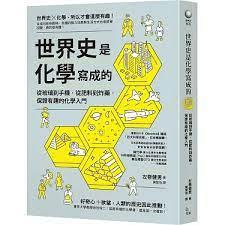Book title: “The history of the world is written by chemistry: from glass to mobile phones, from fertilizers to explosives, a guaranteed interesting introduction to chemistry” (original title: Juetsu に面白いA World History of Chemistry はchemistry でできている)
ISBN:9789861373577
Book Series: Popular Science
Publisher: After all
If someone says that in addition to the deeds of famous figures, world history also includes natural science, especially chemistry, which writes the history of civilization development, what do you think of this statement? I think this book combines chemical knowledge and historical events The different latitude and longitude arrangement is more interesting than a popular science book that only introduces chemistry. It also allows history to escape the name of humanities and see the application of chemistry in daily life.
The first four chapters of this book describe the development of atomic theory, and chapter five begins with examples of how chemistry affected civilization. For example, there is a chapter that mentions that there was a time when the Western world believed that aluminum was more valuable than gold, so it displayed aluminum at the World Exposition and entertained distinguished guests with aluminum bowls instead of gold bowls. This kind of story sounds counterintuitive today. , contrasting the ancient value of rare things being valuable. At that time, the process of manufacturing aluminum was invented by Hall in the United States and Erou in France. They used sodium hydroxide to refine the aluminum ore, add alumina (alumina) after melting, and then use cryolite to electrolyze the molten salt. Finally, the aluminum ore was made. into aluminum.
In modern society, aluminum is still very important and widely used, such as Dura aluminum for manufacturing aircraft and spacecraft structures, as well as super Dura aluminum and 7075 aluminum alloy. The manufacture of permanent magnets also requires the use of aluminum and rare metals. China, which is rich in rare metals, regards them as strategic materials and restricts the export of rare metals. As a result, other countries are researching and developing substitutes.
Another interesting chapter, “Civilization Floating on Petroleum,” features the synthetic fiber nylon, which is a low-molecular-weight polymer discovered by DuPont in 1938. The birth of nylon affected Japan’s stockings and raw silk industries. There are three types of synthetic fibers: nylon, polyester, and acrylic. Among them, polyester has the feel of wool, is heat-resistant, washable, and chemical-resistant. For example, the PET bottle we use to drink our drinks
After crushing its shape and heating, it can be woven into fibrous polyester fiber and can be woven into a shirt. Japan created its own synthetic No. 1 A fiber, but the disadvantage was that it would shrink when exposed to heat, so it invented synthetic No. 1 B fiber in 1940, and in 1948 after the end of World War II, it invented a fiber with good hydrophilicity. The new fiber vinylon is used in student uniforms.
The most thought-provoking part of the book is the last chapter, “War and the Social Responsibility of Scientists.” This chapter begins with scientists such as Haber starting to study poisonous gases in World War I and putting them into actual combat. It introduces various types of deadly poisonous gases such as Jiazi gas that damages the lungs, and reveals that on the Chinese battlefield in World War II, the Japanese army often Poison gas was used to open the way, but due to the shortage of iron materials and the United States threatening retaliation, Japan gradually stopped producing poison gas. Another weapon of war is the atomic bomb, which carries a high temperature of 10 million degrees and creates millions of atmospheric pressures. When burning, it spreads infrared and ultraviolet rays, shock waves and electromagnetic pulses.
The book mentions that Meitner, the female scientist who discovered the fission of the atomic nucleus, declined the invitation to participate in the creation of the atomic bomb, which made me admire her very kind-hearted scientist’s heart. As for the historical question of whether it was necessary to drop two atomic bombs on Japan, this book believes that the invention of the atomic bomb gave the United States a post-war advantage. In order to intimidate its opponent, the Soviet Union, it chose such a fierce and controversial method, and fought against the Soviet Union. Some say that if the garden is not lost, it has nothing to do with how many U.S. troops will be sacrificed. After World War II, scientists also began to promote the peaceful uses of nuclear energy, such as promoting the United Nations Declaration on the Human Environment (Stockholm Declaration), the Russell-Einstein Declaration, and the regularly held Pugwash Conference on Science and World Affairs. Indeed, scientific progress is often accompanied by huge side effects. Without the restraint of human hearts, the earth will be destroyed by these out-of-control inventions, causing unnecessary losses and harm. Preventing problems before they happen is the scientific responsibility that scientists should be responsible for.
Lise Meitner
2023-09-09 10:17:14
#Chapter #history #world #written #chemistry #glass #mobile #phones #fertilizers #explosives #interesting #introduction #chemistry #Square #Vocus
